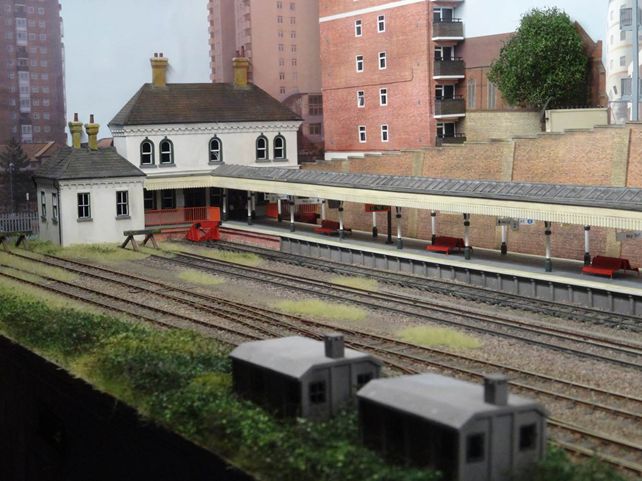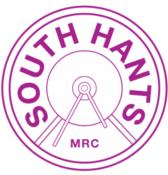SHMRC Annual Exhibition
The following layouts are booked to appear at our next exhibition

Brighton East (4mm scale EM gauge) – David Smith
Brighton East depicts a Southern Region Rail terminus in the period loosely around 1998 to 2003 where 3rd Rail EMU’s prevail on passenger services.
Suppose the old Kemp Town branch as a possible setting for a layout. What if it had retained some passenger service (this actually ceased in the 1933) and had never been shut (it closed to goods traffic in 1971), been electrified and then had a second tunnel bored to allow direct access to Lewes? This is not a protypical rendition, the space was not available to do that, but it hopefully gives a flavour of the small space restricted terminus that was Kemp Town.
The buildings are all scratch built and based on prototypes near to the old Kemp Town station site with the main structure being based on the Barry Building at Sussex General Hospital.
Photograph: David Smith

Clinkerford (4mm scale P4 gauge) – Paul Hutfield
A P4 exhibition layout based on Cinderford Station in the Forest of Dean and featuring other notable building and scenes from the Forest of Dean, including Bicslade Wharf and Stone works, various buildings from Parkend, Whitecroft and Mitcheldean, not to mention the Forest itself completing the scene. Built originally by John Darch, the layout is now owned by Paul Hutfield and exhibited in conjunction with friend’s from the Glevum and Bristol BS4 P4 Area Group’s.
Photo: John Darch

Inspired by Friedrichstrasse (3.5 mm scale, HO gauge) – Liphook & District MRC
Friedrichstrasse is a station with a complicated past. Today it still is a major station, but for 40 years was also a frontier post – the boundary between East and West Berlin. A busy station, it is served by a mixture of local s-bahn services, outer suburban, express, and ‘inter-zonal’ (services to West Germany) trains. All supported by a busy tram service. This model is not a slavish copy of Friedrichstrasse; more an impression of the area and the types of trains seen in Germany (mainly the East) during the late 1960s and 1970s – the period when this layout is set. The layout has a mixture of modified kit and scratch built structures, with the main station buildings being based on the real Friedrichstrasse station. It is digital controlled, featuring trains from most of the main German manufacturers.

Kyle of Lochalsh (2mm finescale) – Pete Matcham
Kyle of Lochalsh was originally built in Barcelona, Spain as a micro layout capable of being transported via boxfiles. It was first exhibited in 2010 at the Burgess Hill Model Railway Club annual exhibition having being flown in by hand luggage the day before. The layout has since had two refurbishments and is now formed of two separate sections, a scenic one and a storage one giving an overall length of 1500mm.
The intention was to try and capture an extract of Kyle of Lochalsh through the inclusion of
the bridge, ramp, station and quayside.
The layout era begins late 70’s to capture the overlap between class 24s and class 26s with the gradual replacement by class 37/4’s. The rolling stock modelled, all being visitors to Kyle, are primarily ready to run models, which have been detailed and the wheels reprofiled to 2mmFS standards.
Photo: Chris Nevard

Longwood Edge (4mm scale P4 gauge) – Presented by SHMRC
This model was designed and built by Iain Rice for, and with, Don Leeper. Sadly, neither Iain nor Don is still alive and we are indebted to Pauline Leeper for allowing us to become custodians of the layout on condition that we finish and exhibit the layout.
Longwood Edge is a real place, high up on the western fringe of Huddersfield in West Yorkshire. Nowadays it’s a leafy suburb, but a hundred and more years ago – the period in which the model is set – it was a village with its own identity. True to its name, the ‘Edge’ clung to the shoulder of a side-valley of the river Calder. Longwood as depicted here is pure fiction, although not an entirely impossible one!
Our Longwood boasts a cluster of textile mills and associated industries, ranging from an eighteenth-century ‘weavers’ row’ to a mid–Victorian mill producing high-grade woollen suiting. The industries around Longwood are served by a short side-branch of the Huddersfield Narrow Canal which terminates in a basin, together with two railways.
Photo: Dave Hawkins

Moors View (2mm scale, N gauge) – Paul Holwill
This layout is a representation of the former L&SWR route from Exeter to Plymouth which loops around the northern edge of Dartmoor, and Moors View itself is set somewhere between Lydford Junction and Tavistock North station. The centrepiece of the layout is the nine arch viaduct which has been built on a gentle curve. With the exception of the road vehicles, the layout is quite date neutral. This means that it is easy to run a wide range of stock and we plan to operate through a long period from 1950s steam through to early 1990s diesels.
Photo: Steve Flint, Railway Modeller

Oak Road (4mm scale, OO gauge) – Mike Buick
A continuous run layout set in recent times. A double track mainline running between Westbury / Bridgwater and Plymouth that passes through a village / town called Oak Road somewhere in either Somerset or Devon and to the side of the station is a single road virtual quarry with a run round loop. Expect to see Cross Country HSTs and Voyagers along with First Great Western stock and some 66s / 59s with IOAs.

Penmaenbach (4mm scale, OO gauge) – Chris Hopper
Penmaenbach is a self-contained shunting layout built using a custom-made Grange and Hodder baseboard kit and PECO Code 75 00 Bullhead track. It is a simple set of sidings which can be used as an “Inglenook” shunting puzzle (using wagon cards if required) as well as a connected branch line and small halt to add operational interest. The buildings are a mixture of scratch-built, plastic and laser cut kits. The bridges are made from styrene sheet. The overall setting is inspired by the railways of North Wales but the layout gives us an opportunity to use a wide variety of rolling stock from the 1980s and later when the BR Rail Blue era was ending. Other stock including Civil Engineers wagons may appear from time to time.
Photo: British Railway Modelling

Portskerra (4mm scale, EM gauge) – Tim Tincknell
Portskerra is the terminus of a ficticious Highland Railway branch line on the north coast of Scotland. Although a branch to Portskerra was proposed as a Light Railway in 1898, and some surveying work carried out, the line never progressed beyond that.
The model uses buildings of typical Highland style and the track layout has features of other Highland termini incorporated. The time period is spring 1915, the increase in traffic due to the Great War bringing many wagons from ‘foreign’ companies to this normally quiet line.
The layout is constructed to 4mm scale, but uses E.M. gauge track for greater accuracy, plain track being C&L with hand built pointwork. Buildings are constructed from plasticard or wood. Grassland uses Noch electrostatic fibres to give a rougher look, while the leafless trees are made from twisted wire covered with filler.
Locomotives are kit built from a variety of sources, rolling stock is kit built, modified or scratchbuilt from drawings available from the Highland Railway Society.

Rodmell Green (4mm scale, 9mm gauge) – Allen Etheridge
Rodmell Green is a representation of a typical narrow gauge cement works railway, inspired by the various works in and around the south east that once existed. The layout gets it’s name from the main buildings, which are loosely based on the ones that used to be at Rodmell cement works near Lewes in East Sussex.
Operation is based around the idea that the cement company are working two smaller quarry faces to serve the works. Loaded wagons arrive from either tunnel, the locomotive will then run round the wagons and propel them through the tipping shed where the wagons are unloaded. Once empty the wagons are returned to the quarry to be reloaded.

Trerice (4mm scale, P4 gauge) – Presented by Jerry Clifford
Trerice is a Cameo model built by the late Iain Rice who sadly passed away in October 2022. This layout and other elements of Iain’s modelling have survived through the good offices of Rice family members and a small group of his close friends who feel the historical importance that was Iain’s contribution to the hobby and more particularly the fine scale branch of it should be preserved, for others to enjoy.
This tiny P4 (4mm scale/18.83 mm track gauge) layout depicts a typical set of Cornish ‘pan’ china clay dries and their associated railway facilities as they would have been around 1960. The buildings are all models of originals in the Goss Moor area of Cornwall, and the railway is based on the Wenford Bridge branch near Bodmin.
The layout features the two locomotive types most often associated with the Wenford Bridge line, the ex-LSW Beattie 2-4-0WT and the GW ‘1366’ class dock tanks. Both these models are largely scratchbuilt – as are all the structures, which feature hand-scribed and painted stonework. The Scenic work incorporates fragments of genuine Delabole slate waste. The china-clay (Kaolin) is also the real thing.

The Wantage tramway (4mm scale, P4 gauge) – Robin Gay
The layout is a 4mm P4 model of the Wantage Tramway as it appeared in the early 1290s. At this period there was a regular passenger service between Wantage Town and Wantage Rd. GWR station. The WT also had a freight contract with the GWR to deliver and pick up all goods around the town and district. This resulted in at least three return goods trains being run each day along the tramway. On market days there would be extra trams would run and even a cattle train, so it is on one of these days that I have decided to portray the tramway for the extra interest.
Though I started the layout several years ago, there are so many building that I had to research, photograph, measure and later build (many of which were knocked down 50 to 70 years ago). It has taken me a long time to get this far and it is still far from finished.
